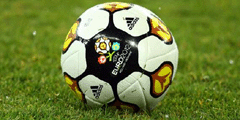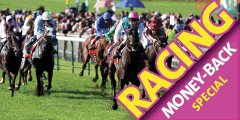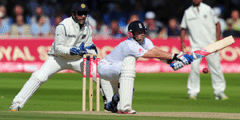Follow our indispensable guide and you’ll be able to tell a ready Denise Lewis from a soapy Dawn French.
Step 1
Like humans, horses will sweat. A small build up of sweat on a horse’s coat is a good sign. A light ring of sweat between a horse’s back legs is also a good sign of keenness. However, a heavy build up that has turned into foam (known as ‘washiness’) is not. Watch out for horse’s working themselves into a sweat shortly before a race.
![]()
Step 2
A horse’s muscular definition is another important factor and there are three main areas to look at. Firstly, look at its hind-quarters for a sharply defined line from a point about a quarter of the way down the rump through to the top of the rear legs. Look for an indication of rib cage. However, too prominent a rib cage could indicate under-nourishment. A chest that is well defined means good fitness.
![]()
Steps 3 & 4
A glossy, shiny coat is an indicator of fitness. But dismissing an animal solely because it has a dull coat would be wrong as naturally shiny coats are rare. Look to the horse’s overall behaviour and appearance. A horse that walks around (going through the motions) with its head held low will often run badly. In contrast, a horse that has a spring in its step and head up looking keen is likely to run well.
![]()
Dull Horses
A dull horse will plod along with his head down and his tail tucked between his legs.This horse will rarely show interest in the crowd and may have his ears turned back most of the time, rather than pricked and alert. During the post parade, a dull horse may show some resistance to breaking into a gallop for the warm-up.
![]()
Sharp Horses
The term ‘sharp’ means that the thoroughbred is bubbling over with energy, so much so that it arrives in the paddock prancing with ears and eyes intent on at what is around him.
The sharp horse may sweat a bit on the neck or between his back legs. The horse may also be making a low squeaking noise with his teeth.
While prancing or jogging on the spot, the horse may have his head tucked down to his chest and his tail pointed outwards and away from his body.
On the track, the sharp horse is anxious to get going. He will break into a canter and gallop immediately, perhaps leaping a bit in the air as he breaks away. During the warm-up on the backstretch and on the turn, the horse is a portrait of controlled strength: neck arched, head down, ears forward, tail up.
The sharp horse might be slightly anxious about going into the starting stall and may dance around briefly before charging into his allotted stall.
![]()
Ready Horses
The majority of races are won by horses that look ‘ready’. They’re not as boisterous or peppery as ‘sharp’ horses, they simply come into the paddock and onto the track looking healthy and ready to win.
Ready horses are more relaxed, yet have an alert look, with their tail raised and removed from their body and a healthy glow on the coat. On the track, the ready horse will trot for just a few strides before breaking off into a warm-up canter.
The warm-up of a ready horse is deliberate but would go unnoticed compared to the sharp horse’s pre-race antics. Behind the starting stalls, the ready horse will take his place in line with little urging.
It is important to take note of when a horse last raced before viewing him on the track. If a horse is returning from a long layoff and appears overly ‘sharp’ he could expend all his energy before the race is run.
![]()
Others
Scared horses are trembling and their eyes are moving quickly and rolling with their nostrils flaring. Some will grit their teeth quickly in an edgy manner. Nervous runners will sweat profusely until the sweat turns into a white foam. An angry horse will have his ears flat back on his head. A sick or hurting horse will move in slow motion with his head drooped and perhaps have a stiff and choppy stride when he warms up.
![]()
Upsets, Mud, Bandages
Every so often, a horse that is very sweaty and appears to be out of control, will win the race after you have eliminated him from consideration based on his appearance.
Sweating up to the degree of washiness, however severe, does not always defeat horses. In fact, washiness combined with fractiousness will often end in victory regardless. In sprints, if horses figure, but appear washy and fractious, punters can accept the horses anyway, certainly at attractive odds.
On a muddy racetrack, look for the horses that are lifting their feet up extra high when trotting. These horses are telling you they do not particularly care for the going.
When the official going is described as ‘Soft’ or ‘Heavy’ watch out for horses showing short, high, or choppy strides during the post-parade and pre-race warm-ups. Prefer a fully extended, fluid gallop in the mud, similar to gallops on dry ground.










